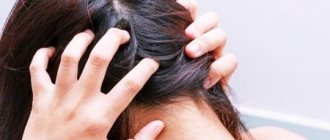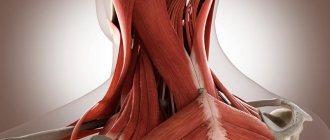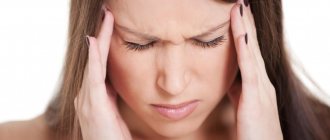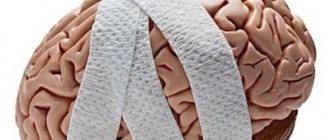| Appointment with a surgeon in Moscow on the same day of treatment | Reception is strictly by appointment, make an appointment by phone: +7 | Prices for services | Reviews about the clinic |
Furunculosis on the head
– a fairly common phenomenon, but painful and dangerous. A furuncle is an acute purulent-inflammatory process under the skin that begins if pathogenic microorganisms enter the hair follicle.
The most common pathogens are streptococci - a common type of pathogenic bacteria that often live on the skin and even in the body of healthy people.
In most cases, they do not lead to the development of diseases, but if the immune system is weakened, then numerous diseases may appear, including furunculosis.
Make an appointment with a surgeon by phone or by filling out the online form
| Select a clinic | Abdominal ultrasound | Gastroenterologist | Calling a surgeon to your home |
Useful information on the topic:
- Treatment of furunculosis
- Causes of furunculosis
- Prevention of furunculosis
- Symptoms of furunculosis
- Furunculosis in the groin
- Furunculosis
- Furunculosis on the back
- Furunculosis on the legs
- Furunculosis under the armpit
- Furunculosis of the buttocks
- Chronic furunculosis
Types of tumors on the head and their signs
Hemangioma
A large growth on the head that occurs when the circulatory system is disrupted. The veins can grow uncontrollably, resulting in a red lump. Under the tubercle you can see a network of blood vessels. Doctors consider hemangioma the most dangerous type of tumor.
It is the hemangioma that leads to disruption and formation of the surrounding tissues of the head. Often this type of tumor is located under the hair. A small hemangioma can grow in size over time and become a malignant tumor. If a hemangioma emerges, you must seek specialized medical help.
Allergic reaction
A bump on the head occurs when the human body is exposed to certain allergens. An allergic reaction is caused by food, household chemicals or cosmetics. Such bumps itch and bring a lot of unpleasant sensations to a person. To avoid the formation of such bumps, you should optimize your diet and buy products only from trusted manufacturers.
Fibroma and sarcofibroma
Fibroma is a benign tumor. It consists of connective tissues of the scalp. Fibroids appear on the back of the head, forehead and other parts of the body. In an adult, the tumor can reach significant sizes. The main factors that provoke the occurrence of fibroids: heredity, diabetes or hormonal imbalance. Fibrosarcoma has similar causes, but is a malignant tumor. If left untreated, it leads to death. Most often, fibroma is hard to the touch and does not cause pain to a person.
Lipoma on the head
Lipomas form on damaged human fatty tissues. These are benign tumors. Women over 30 years of age are susceptible to developing growths. Frequent changes in hormonal levels and impaired fat metabolism lead to the formation of lipomas. Such tumors develop both on the head and on other parts of the body. The lipoma is round in shape and soft to the touch. It can be detected in the hair on the back of the head.
Pimples and bites
A person can detect the presence of a lump if it is bothersome and itchy. It could be a bite or acne. Occurs due to poor hygiene or inflammation of the scalp. It does not require specialized medical treatment and goes away on its own within a few days. To speed up healing, you can use compresses or creams.
Bruise or injury
The human body is often susceptible to various types of bruises. And the head is no exception. With a severe bruise, a tubercle forms, which is very painful when touched. This lump is distinguished by its red color and swelling. Heals on average within a few days. If the headache does not go away, you should visit a specialist. This will help rule out traumatic brain injuries.
A wart is a benign tumor that reaches a significant size. This brings a person a lot of unpleasant sensations, in particular due to appearance. The main factors that provoke the development of warts: hormonal imbalance, inflammation and mechanical damage. Warts, in addition to their slow growth, are capable of multiplying and occupying a significant part of the skin. The cone itself resembles a small brown ball. It's not painful. The wart is constantly growing and reaches 0.5 cm in diameter.
Atheroma on the head
Atheroma is growths on the skin. They occur at any age. Both men and women suffer from this disease. It occurs due to blockage and obstruction of the sebaceous glands on the head. Atheroma has a convex and smooth surface, most often yellow. If atheromas are not removed, they hurt and cause discomfort. Lipoma and atheroma are very similar in appearance, so only a doctor can make an accurate diagnosis after diagnosis.
Wen on the head
A lump on the head is a hard, round tumor. Wen forms over the human skin. Fatty spots occur due to hormonal imbalances and frequent stressful situations. They usually have a non-infectious etiology. If the wen interferes with a comfortable life (clings to clothing), it is removed. Removal takes place in a hospital under the supervision of a doctor.
Childhood is a wonderful time, you can play and fool around, ride a bike and climb trees. Of course, most fun games don't come without bruises, scrapes and bumps. What to do if a child falls and hits his head? Or you found a bump on the head, but the baby did not fall. Should I worry and when should I consult a doctor?
Classification
Classification by tissue from which tumor formation occurs:
- Fatty – liposarcoma;
- Muscular:
- striated muscle tissue - rhabdomyosarcoma,
- unstriated muscle tissue – leiomyosarcoma;
- Vessels:
- circulatory – hemangiosarcoma,
- lymphatic – linfangiosarcoma;
- Connective – fibrosarcoma;
- Synovial membrane – synovial sarcoma;
- Nervous – neurogenic sarcoma;
- Skin – fibrosarcoma.
Carbuncle on the head
A carbuncle (“carbuncle”) is a necrotic inflammation of several boils fused together. The disease is a complication of furunculosis. The process involves the deep layers of the skin and subcutaneous fat. The skin becomes blue-purple. Several necrotic foci appear in the center. After they are opened and the dead tissue is rejected, the inflammation subsides and a disfiguring scar is formed.
With a carbuncle, especially when localized on the head, the condition of patients can be very serious, accompanied by fever and confusion. In severe cases, the disease can be fatal. Treatment is the same as for furunculosis.
What not to do
A tumor on the head can occur for various reasons, but in any case, you should not heat, crush, rub, or try to squeeze out or open the lump. There is no need to try to diagnose yourself. It is prohibited to use folk remedies without first consulting a doctor.
It is necessary to avoid exposing the tumor to direct sunlight, visiting baths and saunas. In case of external transformation of a bump on the head, it is important to contact a specialist as soon as possible.
Self-medication can lead to:
- activation of the purulent process up to sepsis;
- acceleration of tumor growth;
- deterioration of general condition;
- transition to a malignant form;
- development of disability and death.
The bumps on the head are in close proximity to the brain. This increases the likelihood of developing quite unpredictable and severe complications.
When to see a doctor
Sores on the head in the hair require competent consultation with a specialist. Only a doctor can determine the cause of the pathology. If you have a problem with the scalp, you should contact a trichologist. The doctor will conduct appropriate studies and prescribe a treatment regimen.
You should contact a trichologist in the following cases:
- excessive hair loss;
- the appearance of coarse hair;
- excessive oily scalp;
- hair gluing;
- dry skin;
- peeling;
- a feeling of tightness and discomfort in the scalp;
- redness;
- the appearance of oval or round plaques;
- itching
Treatment
Treatment for the resulting lumps depends on the type and cause.
First aid for injury is to apply a cold compress to the injury site (frozen foods are often used for this). Keep for about 10 minutes. Preparations in the form of ointments and gels are also used:
- Troxevasin – strengthens vascular walls, relieves swelling. Rub in gently twice a day.
- Troxerutin - effectively eliminates swelling; it is forbidden to apply to injuries where the integrity of the skin is compromised.
- Heparin ointment - relieves pain and resolves blood clots.
- Rescuer - antiseptic effect.
If insect bites occur, treat with soap and cold; if symptoms persist, use anti-allergenic agents. If necessary, consult an allergist or dermatologist.
For lipoma, self-treatment is not carried out; the help of a surgeon is required. Most often it is removed surgically, with a laser, or using a special substance that resolves fat (injected into the wen itself).
For atheroma, the use of various ointments and folk remedies turns out to be ineffective; they are best used for faster healing after removal or self-opening of the tumor. Removal of atheroma is carried out surgically, laser and radio wave methods.
On this topic
Treatment for fibroids is primarily aimed at eliminating the cause. Next, the tumor is removed using a laser, surgery, cryodestruction (using low temperatures) or radio wave method.
There are several ways to remove a hemangioma:
- Application of liquid nitrogen (no traces are left).
- Microwave cryodestruction – for deep facial tumor localization.
- Radiation therapy – for damage near the eye.
Therapy is carried out exclusively under the supervision of a doctor, since the risk of transformation into a malignant tumor is high.
The boil is removed by a surgeon on an outpatient basis, after which antibacterial and physical therapy is prescribed.
The most effective way to remove a wart is to remove:
- Current therapy is not the most effective method; several sessions are often necessary.
- Freezing with nitrogen is expensive and the surgery leaves visible scars. Long-term postoperative care is also necessary.
- Laser burning is the most widely used procedure and is carried out quickly. No traces remain and similar neoplasms no longer appear.
- Surgical intervention.
Forecast
The prognosis for soft tissue sarcomas of the head and neck largely depends on the size of the tumor, primary location, etiology, and the presence of local or distant secondary foci of malignancy. With early diagnostic measures and adequate timely therapy, the prognosis is favorable.
Bibliography:
- NCCN Guidelines for Patients: Soft Tissue Sarcoma, 2021.
- Shah. Head and Neck Surgery and Oncology 5 ed., 2021.
- Soft tissue sarcomas: a guide for patients – Information based on ESMO Clinical Practice Guidelines – v.2016.1
- Fedenko A. A., Bokhyan A. Yu., Gorbunova V. A., Makhson A. N., Teplyakov V. V. Practical recommendations for drug treatment of soft tissue sarcomas. Malignant tumors: Practical recommendations RUSSCO #3s2, 2021 (volume 9). pp. 272–282.
Osteoma
Symptoms of osteoma, depending on its location:
- upper jaw: headaches, sore throat, impaired motor activity of the mouth, nosebleeds;
- lacrimal and ethmoid bones: visual disturbances, foreign body sensations, displacement of the eyeball.
If the osteoma does not increase and does not have symptoms, it is not necessary to treat it.
Otherwise it is deleted:
- Surgically. The neoplasm is excised along with the periosteum and part of the healthy tissue. This method is used if the osteoma grows rapidly and has a negative effect on neighboring organs.
- Laser evaporation. Excision of damaged tissue with a laser beam. Used for small osteomas.
Secondary osteoma is rare.
This type of disease is another type of tumor. If you look at medical photographs (x-rays), you will see that the tumor forms on the bone. The swelling is very dense to the touch. However, no matter how frightening it may look, it does not pose any danger to the patient. When formed, it does not itch or hurt, and a person does not feel any discomfort on the head.
As a rule, these types of tumors on the head appear in children and adolescents in the age group from 4 years to 21 years. There are two development options:
- When you press on this growth, painful sensations will occur.
- An option with a painless development of the situation is also possible.
It is worth remembering that if the types of lumps that appear cause even minor pain, then you need to consult a doctor
Warts
They can be located in the form of bumps on the forehead above the eyebrows and not only, causing unpleasant sensations to the person. However, they do not cause any pain. Quite a lot of warts form over a person’s entire life, and they do not have to be removed.
The exception is the occurrence of various infections. The reason why warts appear is infection with the human papillomavirus. They are capable of growing and reaching a size of 0.5 cm. For warts on the head under the hair, treatment will consist of several stages, the implementation of which guarantees getting rid of the bumps on the head.
First, a sick person should consult a dermatologist, who will prescribe a histological examination, as well as dermatoscopy. Then a medicinal course of treatment will be prescribed, including antiviral drugs of general and local action. In some cases, laser wart removal is used.
Prevention
There are primary and secondary prevention of bumps on the head. The primary goal is to prevent the process of tumor formation. This includes proper, nutritious nutrition, giving up alcohol and smoking, reducing the likelihood of contact with carcinogens, and increasing the body’s immunity. It is also recommended not to sunbathe and be careful to reduce the likelihood of injury.
Secondary includes early diagnosis and timely treatment of bumps on the head. Clinical examination and preventive examinations are of great importance. If necessary, patients are monitored and undergo a course of rational, consistent recovery.
In most cases, bumps are not very dangerous, especially painless ones. However, it is always better to consult a doctor to find out the cause and nature of the tumor, thereby eliminating possible complications.
Causes
The reasons for the appearance of cones are varied, so they can be divided into several separate groups:
- bumps after injury. Impact or bruise of soft tissues is the most common factor in the development of a tumor. As a result, swelling forms, and the bruised area is very painful. As a rule, such bumps go away on their own without serious treatment. Cold compresses and applying heated cabbage leaves will help speed up the recovery process. Also in such a situation, iodine in the form of a grid is effective. Relevant for injuries to the forehead and back of the head. If tumors form, you should consult a doctor in order to exclude the possibility of traumatic brain injury;
- bump from a bite. Small swellings on the forehead, head, and body can occur as a result of an insect bite. This is an allergic reaction to the saliva secreted by the parasite. As a rule, you can see a small point on the surface through which the poison penetrates. The diameter of the affected tissue can reach 2-3 cm. Such bumps go away on their own or after using antihistamines. They are very itchy and have a dense consistency;
- lump in the form of a subcutaneous formation. Such tumors do not respond to standard treatment and slowly increase in size. Such growths include atheromas, lipomas, fibromas, hemangiomas, and warts.
Warts
These are benign formations on the skin, consisting of connective tissue and covered with epithelium. Warts appear on any part of a person’s skin, including on the head. Doctors distinguish several types of wart bumps in humans: regular, flat, plantar, senile and pointed. The cause of warts in humans is infection with the papilloma virus, which can be transmitted through household contact, as well as through contact with an infected person. After infection and the first appearance of a wart bump on the skin, a long time may pass. If one wart appears on the skin, then in this case the patient should be very careful with it so as not to damage it, otherwise this virus can be spread throughout the body. There are many different methods for treating warts with folk remedies, using compresses, ointments and various tinctures, however, before using them, you must first consult with a specialist, as this can significantly harm your body. Traditional medicine to remove a bump on the head involves the use of methods such as surgery, radio wave therapy or laser removal. The doctor himself determines which method to choose.
When a bump appears on your head, you should not despair, especially since it is not painful. And the first thing to do is visit the doctor's office in order to rule out serious diseases and, if necessary, receive appropriate treatment.
A bump on the head may be the result of a blow. It usually doesn’t hurt and doesn’t cause much discomfort. However, its appearance is not always so harmless. If the lump is suspicious, very painful, swollen, and even the temperature has risen, and is localized on the back of the head or on the sides of the skull, then it is still worth identifying the cause of its appearance. A lump may appear as a symptom of a neoplasm or other pathology in the body that requires diagnosis and treatment, possibly even surgery.
A bump on the head can appear as a result of external trauma: from a bruise or an insect bite, or internal: from a lipoma in the form of a wen, osteoma, furunculosis, kateroma (cyst formation), trichoepithelioma, enlarged lymph nodes.
- Injury. The lump appears on the head in the form of a hematoma with an accumulation of blood under the skin, hurts on palpation, and takes on a lilac or eggplant hue. It is necessary to treat, open surgically, clean the wound from accumulated blood and possibly pus.
- Mosquito, bee or wasp bite. Swelling on the head, burning sensation, pain, itching, and fever may occur. Treatment consists of treating the affected areas, washing with antiseptics, and applying antiallergic ointments (gels). You can't scratch the bump. It is better to immediately go to the emergency room for help, especially if the temperature rises and severe itching overcomes.
- Atheroma in the form of a neoplasm localized on the head due to insufficient outflow of the secretion of the sebaceous glands, their blockage, and the accumulation of a dense consistency under the skin. Requires surgical removal and examination of the material for histology. Usually this is a benign cyst of origin.
- Lipoma in the form of a wen, a benign tumor of dense consistency. Usually the lump does not hurt and does not cause much discomfort. Localizes the forehead and scalp. Appears as a result of metabolic failure and pathology of adipose tissue. It is hereditary in origin and can degenerate into liposarcoma, a malignant neoplasm that requires removal by laser, cryodestruction or surgery.
- Trichoepithelioma is a benign tumor on the head that is usually hereditary. It can be grouped in the form of dome-shaped numerous small elements on the head up to 6 mm in diameter, growing over time, usually not painful on palpation. Treatment involves surgery or electrocoagulation.
- Osteoma in the form of a benign cyst with slow growth, but not capable of degenerating into a malignant form, metastasizing, or growing into nearby tissues. The lump hurts, but sometimes it is not felt at all. Smooth to the touch, slightly raised above the bone tissue in the shape of a ball with smooth edges. The cause of the appearance may be heredity, injury, a number of diseases: gout, rheumatism, syphilis. It must be removed by cutting off nearby healthy areas of bone tissue.
How to get rid of acne on your head
- You can get rid of acne on your head through treatment. To do this, you need to consult a trichologist, who, after diagnosis, will prescribe a treatment that is suitable for you.
- Pimples can disappear if the underlying disease causing their appearance is eliminated: for example, stomach problems, etc.
- Folk remedies: solarium (dries out the skin, reduces the production of sebaceous glands); homemade hair masks and shampoos.
Traditional recipes for getting rid of acne on the head
This problem needs to be approached comprehensively. In addition to the individually selected medications that your doctor will prescribe for you, based on the test results, you should also turn to traditional medicine. These recipes have been collected by our grandmothers for many years. They relieve itching well and eliminate purulent inflammation.
It has antiseptic properties. This product should be used no more than 4 times a month. We buy colorless henna for hair in a specialized store and pour it into a shallow bowl. Fill with one glass of hot water, it should be no more than 70 degrees. Let it sit for several hours. Then add one chicken egg and mix well until smooth. Apply the product to the scalp and leave the product on for about 30 minutes. Next, rinse your hair and head well, you can use shampoo.
Tincture of calendula
This product can be easily purchased at any pharmacy, and it is inexpensive. It has the ability to normalize the functioning of the sebaceous glands. To prepare the solution, take 2 tbsp. tinctures and mix with 250 grams of water, blot a cotton pad and wipe the scalp 2 times a week.
Tea tree oil
Has antibacterial and antiseptic properties. To solve such an unpleasant problem as acne, you just need to add a couple of drops of this product to your shampoo.
Aloe juice
This remedy has anti-inflammatory, antibacterial and wound-healing properties. We cut off the lower and thick leaves of this plant. They contain a large amount of juice. Squeeze the juice out of them and apply to the scalp. After this, you need to put on a hat and wrap your head in a towel. After half an hour you can wash it off.
Apple vinegar
The solution should be diluted in advance: 100 ml of vinegar per 100 ml of water. First, wash your hair with shampoo and then rinse with the prepared product. After 5 minutes, rinse your hair well with water without using shampoo. This will avoid an unpleasant odor.
This soap can be found at a pharmacy or in the hardware department of any supermarket. It is also available in liquid form, but this product costs much more (about 150 rubles).
Honey and cinnamon mask
Preparing such a remedy will not be difficult. Take 2 tbsp. honey and 1 tsp. cinnamon, mix well. Apply the resulting product to problem areas or the entire head. You can wash off the mask after 30 minutes.
Strawberry juice
Only freshly squeezed juice is suitable. It cleanses the scalp well. This juice destroys many pathogenic bacteria and also heals wounds. It contains a large number of vitamins and microelements. Periodically you need to lubricate the affected areas of the head.
Anise
Perhaps the most valuable part is the seeds. They contain a large amount of vitamins and minerals. This plant has analgesic, antiseptic and anti-inflammatory properties. Anise fruits can be purchased at the pharmacy. They should be filled with warm water and left to swell overnight. In the morning, grind the seeds into a paste. We apply it to the affected areas of the scalp. Leave it on for about an hour and then wash it off. This mask can be done 3 times a week.
Salt baths
There is one BUT in this method! If previously such a composition contained only natural ingredients, now it contains many artificial additives, so it can be used for no more than 2 weeks. We purchase a special composition and take a bath with it every day.
As you can see, there are a lot of folk and cosmic remedies for combating rashes, but the main task is to identify the cause of their appearance. In the presence of gastrointestinal diseases, folk remedies and space remedies will not be effective.
Symptoms
Symptoms are determined depending on the type of formation.
Injury
Painful sensations appear when pressed, redness and swelling occur. With more serious injuries, which indicate a closed craniocerebral injury, the following symptoms occur:
- Loss of consciousness occurs immediately after the injury. At this time, the patient does not respond to external stimuli and does not feel pain.
- Pain in different parts of the head - begins immediately after regaining consciousness.
- Nausea and vomiting do not give a feeling of relief.
- Dizziness.
- Hematoma - most often occurs with fractures of the bone frame of the skull. You can often observe the ear and near the eyes.
- The face and neck become red.
- Amnesia - a person does not remember events that happened before the injury (occasionally there are cases when a person forgets events that happened after the injury).
- Development of convulsive syndrome.
- Increased sweating.
Diagnostics
The diagnosis is made based on histological examination of tumor tissue.
There are two methods for obtaining material for research:
- core needle biopsy;
- open biopsy.
The biopsy should be performed in the location that during the operation will be included in the area of excision of the tumor formation.
Diagnostic algorithm:
- Examination: A lumpy, rounded yellow or gray nodule may be observed. It can have different densities and consistencies. Soft nodes - with liposarcomas, dense - with fibrosarcomas, jelly-like formations - with myxomas;
- Complete blood count with calculation of leukocyte formula and platelet count;
- Biochemical blood test with determination of liver and kidney function indicators (including electrolytes);
- Coagulogram;
- MRI of the head and neck area;
- CT scan of the lungs;
- Ultrasonography;
- Radioisotope study of skeletal bones (for myxoid liposarcomas);
- CT scan of the brain (for alveolar soft tissue sarcoma and hemangiopericytoma).
Important: for the purpose of initial examination and clarification of the stage, routine PET scanning is not recommended.









